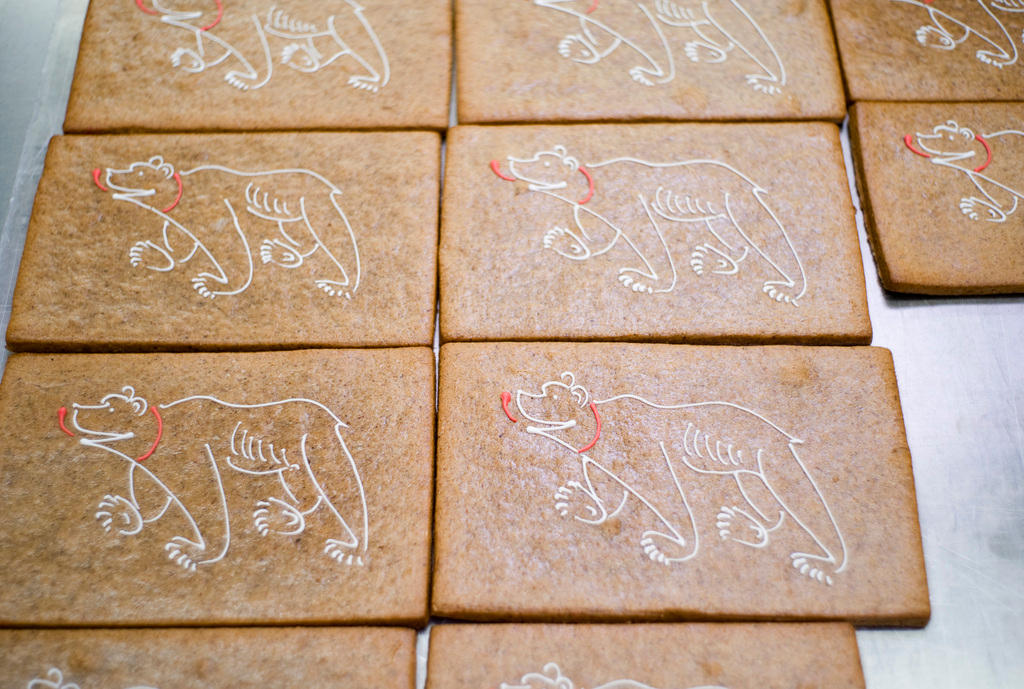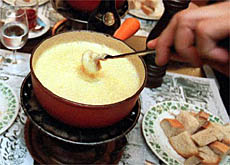History shows there’s more to fondue than cheese

Fondue could be seen as a symbol for Switzerland and its institutions: a mix of ingredients combined with respect for precise rituals governing preparation and enjoyment.
While debate about the authentic recipe is endless, no one disputes that the melted cheese dish has long been part of the national cuisine.
The ingredients, and the way fondue is eaten, recall the legendary “Kappel milk soup” of 1529 when, after a battle, Catholic and Reformist Confederates resolved their differences over a huge steaming pot of creamy, milk-based soup.
But the popularity of fondue is more likely the result of living in a consumer society with industrial production of food, and diverse methods for publicizing Swiss cheese abroad.
Melting or roasting a fatty cheese and adding whatever condiments one had available was a traditional practice of Alpine dwellers and cattle breeders. The custom spread from the Gruyères region to the plains, probably in the course of the 18th century.
European origins
The celebrated French politician, judge and author, Jean-Anthelme Brillat-Savarin (1755-1826), conferred a certain gastronomic dignity upon fondue and attested to its Swiss origin.
However, according to the recipe quoted in “Physiologie du goût” (1825), the dish was based on beaten egg, Gruyère cheese and butter, blended into a creamy mixture.
In “Scienza in cucina” (1891), the Italian man of letters Pellegrino Artusi (1820-1911) – who claimed not to enjoy this dish – came up with a Turin version called cacimperio, which involved fontina cheese and milk. But he made no mention of the characteristic way of eating it, by dipping bread into the simmering mixture.
The current recipes which call for cheese to be melted in white wine appeared only at the beginning of the 20th century, when various regions in western Switzerland competed with each other to be the home of genuine fondue, based on a mix of cheeses.
International fame
Fondue came to be promoted as a genuine Swiss speciality in the 1930s when strenuous efforts were undertaken to sell surplus hard cheese.
The dish’s international fame was boosted considerably when it was presented at the World Fair in New York in 1940.
Throughout Switzerland, it became much more widespread once ready-to-use mixes were launched onto the market in the 1960s.
The consumer society has also made it easier to acquire the necessary utensils (a burner, an enamelled clay pot and special forks) which have since become a popular, but not very original, wedding present for friends and relatives.
Like pizza, fondue permits endless variations, both in terms of the contents of the pot (cheese mixed with wine or other liquids, oil, broth or chocolate) and the food used for dipping (bread, potatoes, meat, fish, vegetables, fruit).
In fact, at New Year at least, “fondue chinoise” – meat dipped in hot broth – can now be considered the real Swiss national dish.
swissinfo, Marco Marcacci
The main ingredients of a traditional fondue are cheese, or a mixture of cheeses, wine and cherry brandy, and bread for dipping.
Fondue chinoise – meat dipped in a pot of hot broth – is traditional at Christmas and New Year.
The utensils needed for a fondue are a burner, an enamelled clay pot and special forks.

In compliance with the JTI standards
More: SWI swissinfo.ch certified by the Journalism Trust Initiative











You can find an overview of ongoing debates with our journalists here . Please join us!
If you want to start a conversation about a topic raised in this article or want to report factual errors, email us at english@swissinfo.ch.